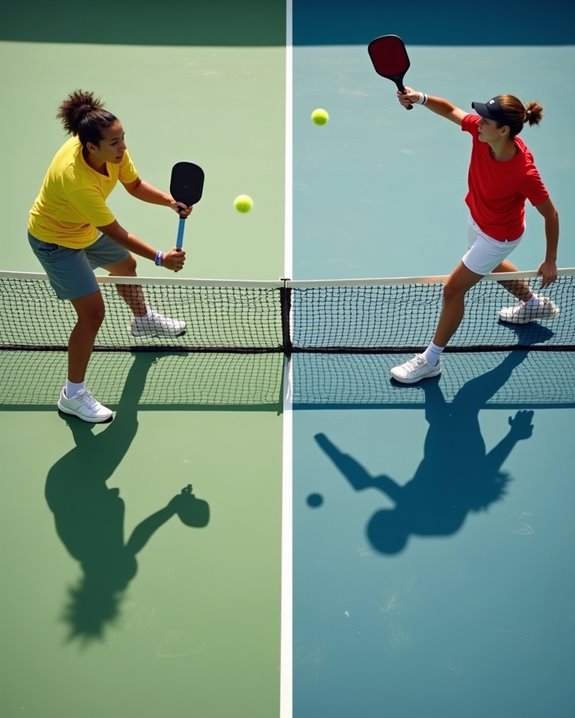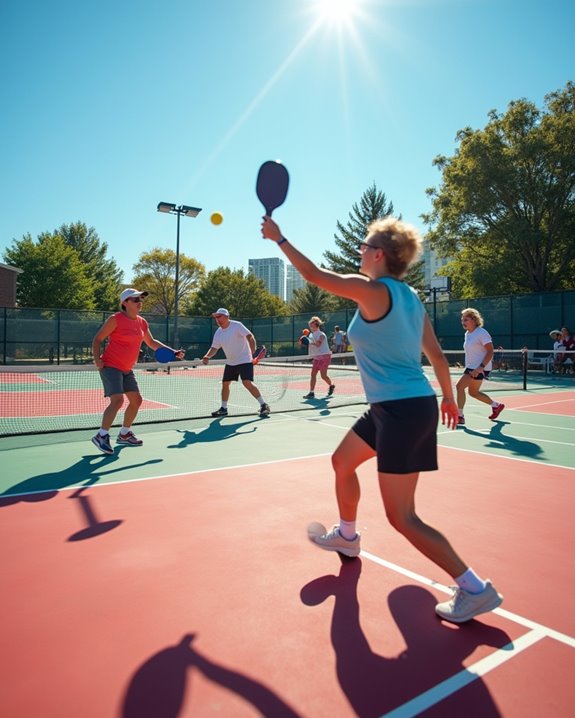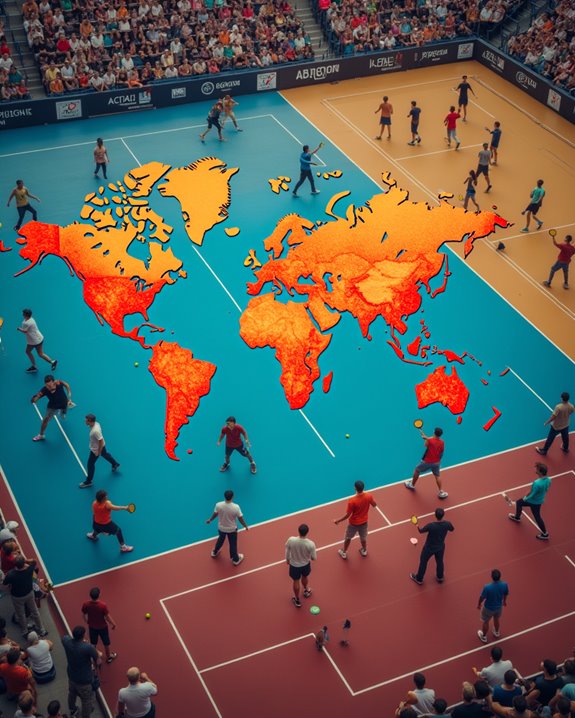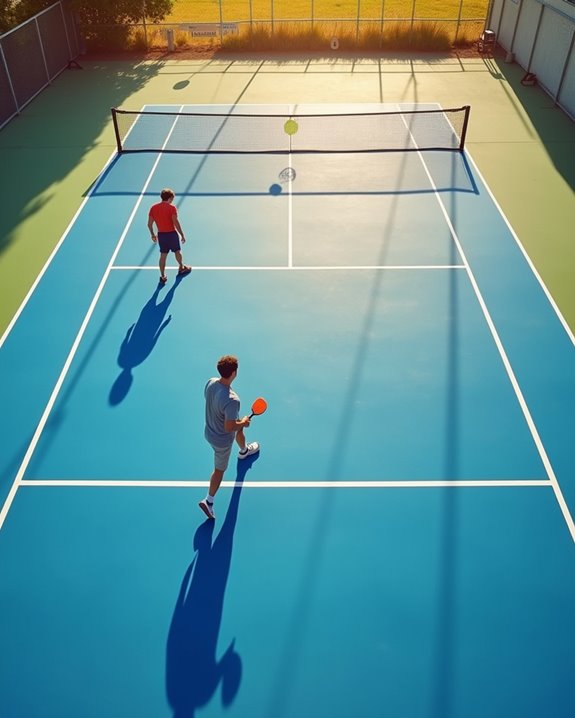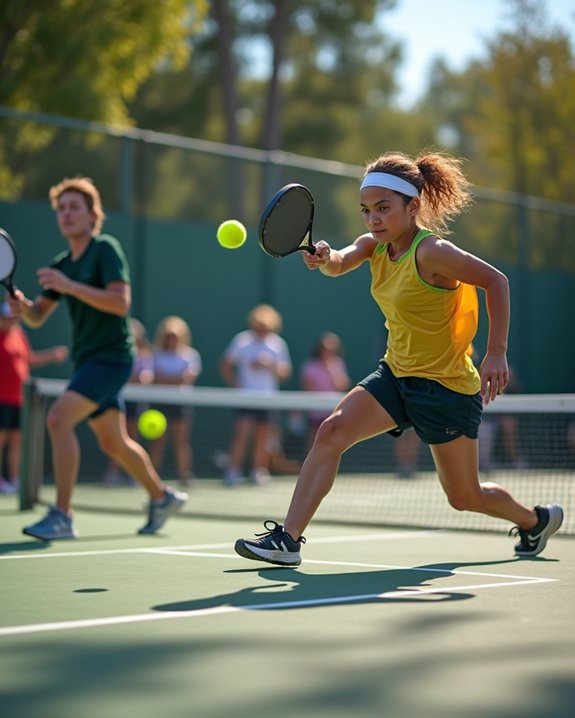Pickleball and tennis differ considerably in their fundamentals. You’ll play pickleball on a court half the size of tennis, using a lighter paddle instead of a strung racquet. The unique “kitchen” zone and two-bounce rule in pickleball prevent aggressive net play, while the underhand serve differs from tennis’s overhead motion. Pickleball’s scoring system is simpler, with games lasting 15-30 minutes versus tennis’s potentially hours-long matches. Discover how these distinctions might better match your athletic preferences and goals.
Key Takeaways
- Pickleball courts (44′ x 20′) are less than half the size of tennis courts (78′ x 36′).
- Tennis uses strung racquets weighing 11+ ounces while pickleball uses solid-faced paddles weighing 7-9 ounces.
- Pickleball has unique rules including the two-bounce rule and non-volley zone restrictions that tennis lacks.
- Tennis serves are overhand with two attempts allowed, while pickleball requires underhand serves with only one attempt.
- Pickleball matches are shorter (15-30 minutes) with points to 11 or 15, while tennis matches can last hours.
Court Size and Net Specifications
The two most striking differences you’ll notice when comparing pickleball and tennis are the court dimensions and net setup. Tennis courts are substantially larger, measuring 78 feet by 36 feet, while pickleball courts are more compact at just 44 feet by 20 feet—similar to reducing a hearty lasagna to a personal-sized quiche!
You’ll find the net height varies too. Tennis nets stand 36 inches at center and rise to 42 inches at the posts, while pickleball nets are lower at 34 inches center and 36 inches at posts.
Unlike tennis courts with their doubles alleys, pickleball courts maintain consistent dimensions regardless of player count. The unique “non-volley zone” or “kitchen” extends 7 feet from the net—a restricted area that adds strategic flavor to your pickleball game.
Equipment and Ball Characteristics
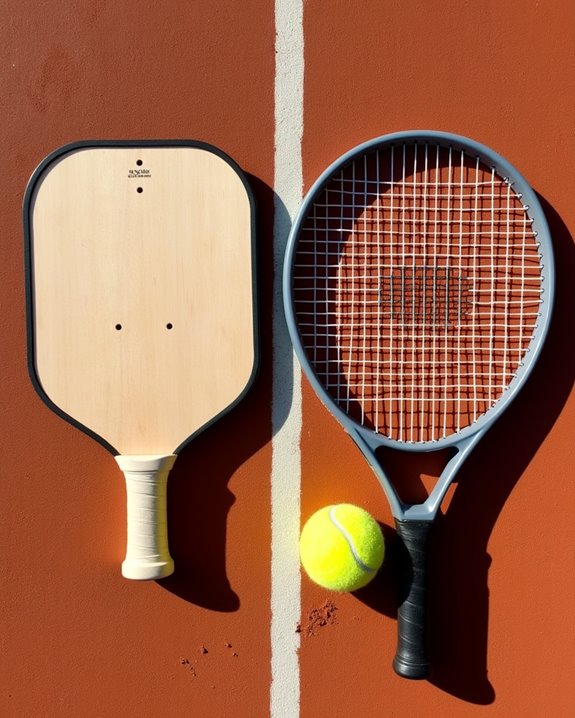
Moving from court dimensions to what you’ll actually hold in your hands, comparing pickleball and tennis equipment is like contrasting a delicate pastry knife with a meat cleaver! You’ll immediately notice pickleball paddles are 24% lighter than tennis racquets, weighing just 7-9 ounces compared to tennis’s 11+ ounces.
The difference extends to their construction too. Tennis racquets are strung like a delicate web, while pickleball paddles feature solid faces—wood, composite, or carbon fiber—each offering unique spin capabilities. Additionally, many pickleball paddles utilize core materials that enhance performance and control, making them suitable for various playing styles.
As for the balls? Tennis balls are hefty at around 2 ounces with a high bounce (53-60 inches). Your pickleball, however, is a lightweight plastic ball (under 1 ounce) with 26 or 40 holes that create distinctive play dynamics with a modest 0-34 inch bounce. These equipment variations fundamentally transform how you’ll experience each game!
The Two-Bounce Rule and Non-Volley Zone
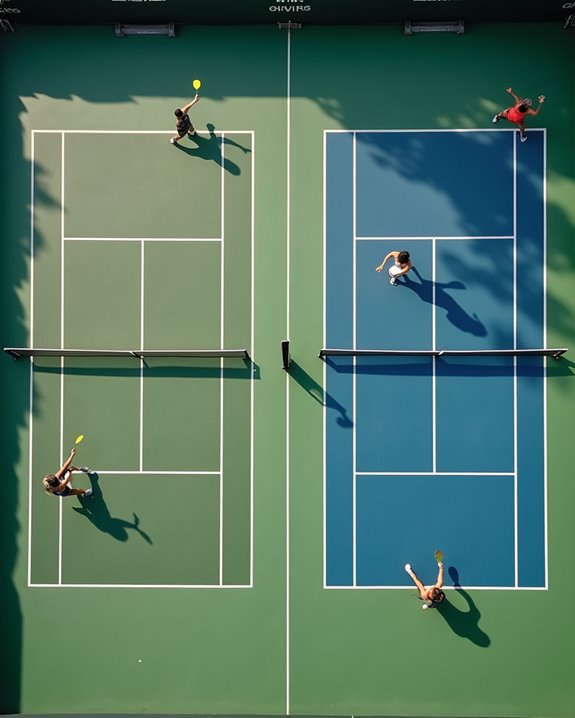
While tennis allows immediate volleys after service, pickleball’s unique flavor comes from its two-bounce rule and non-volley zone—ingredients that completely transform the game’s recipe!
When you serve in pickleball, the ball must bounce on both sides of the net before players can start volleying. This two-bounce rule creates a more measured opening to each point, like letting a sauce simmer before bringing it to a boil. The non-volley zone (aptly nicknamed “the kitchen”) extends 7 feet from the net, where you’re prohibited from hitting the ball out of the air. You can enter this area, but only to return balls that have already bounced.
These distinctive rules create a strategic dance around the kitchen that you won’t find in tennis, encouraging patient shot preparation rather than aggressive net rushing.
Serving Techniques and Requirements
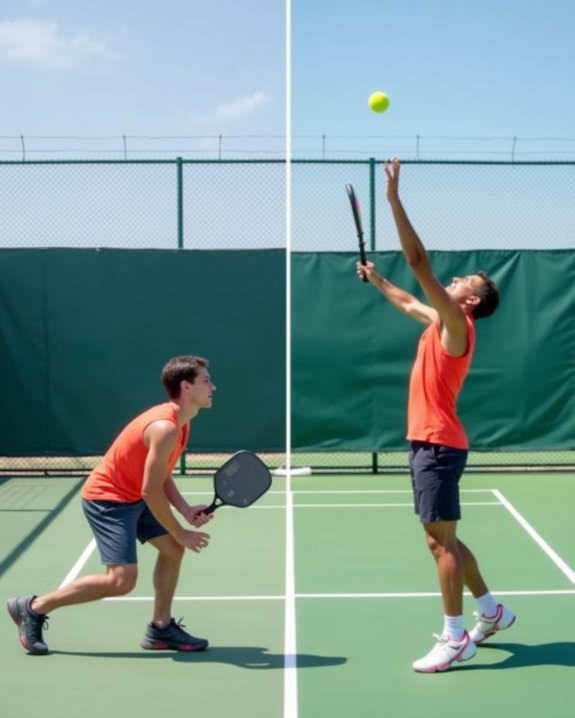
Serving in pickleball feels like folding delicate ingredients into a soufflé—technique matters tremendously! Unlike the power-driven tennis serve, your pickleball serve must be executed underhand, below the waist, creating a gentler entry into play. You’ll need to achieve diagonal placement into your opponent’s service box, similar to tennis, but with a significant difference—in pickleball, you must clear the non-volley zone (affectionately called “the kitchen”).
While tennis allows you two chances at serving, pickleball offers just one attempt. You’ll also notice the drop serve technique, where you’ll let the ball bounce before striking it—like giving your dough a moment to rest before baking. Remember, only the serving team can score points in pickleball, unlike tennis where every rally counts toward someone’s score. Master these serving differences, and you’ll be ready to simmer up some serious competition!
Scoring Systems and Match Duration
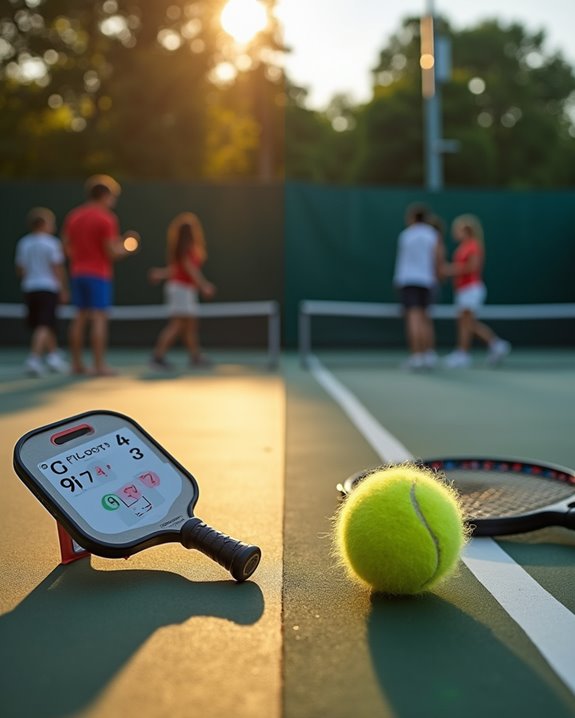
After you’ve mastered the art of serving, let’s heat things up with the sizzling world of scoring!
When you play pickleball, you’ll find the scoring system as straightforward as following a simple recipe—games typically simmer to 11 or 15 points with a two-point lead needed to serve up a victory. You’ll announce the score before each serve, like calling out ingredients before mixing. Tennis, meanwhile, offers a more complex scoring feast of games and sets, garnished with unique terms like “deuce” and “advantage.”
The match duration varies too. Pickleball games are quick-fire affairs—15 to 30 minutes, like preparing a tasty appetizer. Tennis matches, however, are more like slow-cooked main courses, often simmering for hours. Rally scoring in pickleball means points can be scored regardless of who’s serving—keeping the action piping hot!
Frequently Asked Questions
What Is the Main Difference Between Pickleball and Tennis?
When you’re comparing pickleball and tennis, the main difference lies in equipment differences and court dimensions. You’ll notice tennis uses stringed racquets on larger courts while pickleball uses solid paddles on smaller courts.
What Is Harder, Pickleball or Tennis?
Picture yourself sprinting across a tennis court—it’s harder than pickleball due to larger court size, heavier equipment, faster game pace, and steeper learning curve. You’ll need more stamina, though both require strategic play.
What Do Pickleball and Tennis Have in Common?
You’ll find both sports share similar court dimensions, scoring systems, game strategies, player positions, equipment choices, and ball types. They’re accessible at various skill levels, offer social aspects, appeal across age demographics, and carry injury risks.
What Is the Difference Between Pickleball and Table Tennis?
Like David and Goliath, you’ll find pickleball’s larger court contrasts with table tennis’s tiny table. You’ll use different rackets, balls, and serves. The scoring systems vary, and you’ll notice distinct strategies and movement patterns in each sport.

